Materials and Products Development Based on a Novelty Approach to Quality and Life Cycle Assessment (QLCA)
Abstract
:1. Introduction
2. Materials and Methods
2.1. Assumptions of Method
- the subject of the research includes materials and products that can be subjected to qualitative and environmental assessments during their life cycle [17];
- the environmental assessment is carried out according to one environmental load criterion, which is selected based on the type of materials or products being verified [18];
- environmental assessment is carried out according to the ISO 14040 standard [19] as a life cycle of materials and products, i.e., taking into account the phases of obtaining and extracting the materials, and their production, use and end of life. As a result, the LCA indicator is determined as environmental impact in the life cycle;
- the quality index (Q) and the environmental index (LCA) are aggregated into one QLCA index, where the ranking created on this basis helps determine the most favourable direction for the development of materials and products in order to simultaneously meet customer expectations regarding usability and reduce the negative environmental impact in the life cycle.
2.2. Description Process of Method Development
- Determining the purpose and scope of the research. The purpose of the research should be defined, which refers to predicting a prototype of a material or product that is the most advantageous in terms of quality (customer satisfaction with usability) [24] and, at the same time, environmentally friendly in terms of LCA [25]. The scope of research should include: (i) assessment of the quality of the materials and products and their prototypes, (ii) assessment of the environmental impact of the materials and products during their life cycle and modelling of the environmental impact of prototypes using LCA, and (iii) the integration of quality assessment with environmental assessment as part of determining the direction of material and product improvement in terms of their sustainable development. The scope should be established based on the LCA approach, i.e., from cradle-to-grave, taking into account material extraction and processing, production, use, and end of life [26].
- Defining the system boundary and adopting a functional unit. A system boundary defines a set of criteria that relate to the processes, inputs, outputs, and environmental loads to be analysed. The process selected for verification may concern all or selected LCA phases, where the proposed approach assumes the entire life cycle. A system boundary is also a geographical area or time range that includes data related to a product or process [2,27]. However, the functional unit is a quantitative description of the product’s functions that corresponds to the data in the environmental load calculation process. The functional unit can be freely adopted, e.g., in international metric units. Its introduction supports the comparison of research results [28].
- Preparation of inventory data. It is necessary to develop a data set to conduct a life cycle assessment of materials and reference products, as well as to assess their quality. Such data can be obtained from databases of environmental assessment programmes and catalogues (specifications). Data should be specified separately for the environmental and quality assessment processes [29]. In the case of an environmental assessment, these data should include materials and raw materials obtained and processed, along with elements implicated in the production, use, and end-of-life processes, including energy and waste [30]. However, for qualitative evaluation, it is necessary to determine the criteria (attributes) that characterise the materials and products to be analysed. These should be the main criteria that influence customer satisfaction with the use of the product. Their number should not exceed 10 [31]. Quality criteria should be described according to parameters in the current state (reference product) and modified state (prototypes), where the number of these states should not exceed 10 [31]. The current and modified states are presented by a value, range of values, or description.
- Life cycle assessment of the reference product. An assessment of the life cycle of the materials and the reference product, i.e., the current product (product offered on the market) is carried out [32]. Depending on needs, a life cycle assessment is performed for selected phases of the LCA, or the entire life cycle. It is assumed that this is a “cradle-to-grave” approach, i.e., taking into account all phases of the life cycle (obtaining and extraction of materials, production, use, and end of life) [33]. Life cycle assessment is carried out according to the ISO 14040 standard [19], where the results of the life cycle assessment concern one selected environmental load criterion that is adequate for the research problem. The result of the life cycle assessment is presented by the so-called LCA index [34].
- Assessment of the quality of the reference product and its prototypes. On the basis of the quality criteria (selected at the third stage of the method), customer requirements are obtained and processed. Depending on the specificity of the product, the entity using the method may obtain expectations from the customer or customers. Expectations can be obtained in various ways, e.g., via survey or interview. A survey should include product criteria and their states. The customer assesses the importance of the criteria and, in turn, satisfaction with the criteria states. Ratings are given on a five-point Likert scale, where 1 indicates that the criterion is not very important/the criterion is not very satisfactory, and 5 indicates that the criterion is very important/the criterion is very satisfactory. The methodology of the Likert scale is shown in [35]. An arithmetic mean is calculated from the customer ratings, presenting the values of the criteria weights and, in turn, the values of customer satisfaction with the quality of the criteria states. It should be mentioned that the method of data collection and analysis used may be influenced by many factors, e.g., the demographic profile of the respondents resulting from the specificity of the analysed product. In the case of a large research sample, the results from the survey may be processed using appropriately selected statistical methods or as part of the estimation of the arithmetic mean of the customer ratings awarded to a given criterion. The number of test customers can be determined according to the methods presented in [35,36]. Based on these values, it is possible to initially calculate the weighted quality of the criteria states. The WSM (weighted sum model) method [37] is used for this purpose, which is a simple decision support method based on the product of two arbitrary values, as shown in Formula (1) [38,39]:where w is the value of the weight of the i-th criterion; y is the value of the quality of the state of the i-th criterion; and i = 1, 2, …10.
- 6.
- Prediction of prototype quality and prospective assessment of its life cycle. Based on selected criteria states of materials or products, prototypes are offered, i.e., alternative design solutions corresponding to the quality of materials and products. The prototypes are defined by an expert team and should contain various modifications of the quality criteria states [40]. An effective comparison of different alternatives is possible if it covers no more than 10 production solutions [31]. Based on the proposed prototypes, the quality index (Q) is determined. For this purpose, a multicriteria decision support method known as the entropy method is used [41]. This method supports objective validity, which involves measuring various information and the weights of decision-making indicators through information entropy [42,43]. The entropy method is also suitable for analysing any quality criteria (measurable or unmeasurable) that cover various product alternatives. Therefore, the prototypes that are initially adopted and the corresponding quality criteria states are described by the values of the weighted quality of the criteria states (obtained from an earlier stage of the method). They are saved in the so-called decision matrix. Then, these values are normalized according to Formula (2) [44]:where q is the weighted quality of criteria states; m is the number of alternative design solutions; and i, j = 1, 2, …, n.
- 7.
- Aggregation of results and their interpretation. Values of the quality indicator (Q) and the environmental burden indicator (LCA) are aggregated into one quality and environmental indicator (QLCA). This is represented by Formula (6):where Q is the quality indicator; LCA represents the environmental burden in the life cycle of the product or prototype; and j = 1, 2, …, n.
2.3. Data of Case Study
2.3.1. Purpose and Scope of Research
2.3.2. System Boundary
2.3.3. Functional Unit
2.3.4. Inventory Data
3. Results
3.1. Life Cycle Assessment of the Reference Product and Its Prototypes
3.2. Quality Assessment of the Reference Product and Its Prototypes
3.3. Prediction of Prototype Quality and Prospective Assessment of Their Life Cycle
3.4. Aggregation of Results and Their Interpretation
4. Discussion
- in-depth analysis of customer requirements regarding the quality of materials and products, including their prototypes, which is aimed at predicting user satisfaction;
- ensuring a prospective life cycle assessment of materials and products, including their prototypes, based on modelling the value of environmental load in relation to the offered changes in quality criteria (attributes);
- aggregation of the quality indicator (Q), related to the quality of materials and products, with the environmental burden indicator throughout their life cycle (LCA), based on which it is possible to predict the most advantageous product alternative;
- supporting the process of improving materials and the products made from them in terms of their sustainable development in the life cycle.
5. Conclusions
Author Contributions
Funding
Institutional Review Board Statement
Informed Consent Statement
Data Availability Statement
Conflicts of Interest
Appendix A
| Criteria and Their States | Weighted Quality Criteria States | |
|---|---|---|
| Season | All year round | 25 |
| Summer | 25 | |
| Winter | 25 | |
| Tyre class | Premium | 20 |
| Middle | 16 | |
| Economic | 12 | |
| Size | 205/55R16 | 25 |
| 155/65R14 | 25 | |
| 155/70R13 | 25 | |
| 175/70R13 | 25 | |
| 185/65R15 | 25 | |
| 155/65R13 | 25 | |
| 175/70R13 | 25 | |
| 165/60R14 | 25 | |
| Index load capacity | 100–800 | 9 |
| 101–825 | 9 | |
| 102–850 | 9 | |
| 103–875 | 12 | |
| 104–900 | 12 | |
| 105–925 | 12 | |
| 106–950 | 15 | |
| 107–975 | 15 | |
| Index speed | H to 210 km/h | 12 |
| Q to 160 km/h | 9 | |
| R to 170 km/h | 9 | |
| S to 180 km/h | 12 | |
| T to 190 km/h | 15 | |
| V to 240 km/h | 15 | |
| W to 270 km/h | 12 | |
| Y to 300 km/h | 6 | |
| Resistance rolling | Class A | 10 |
| Class B | 15 | |
| Class C | 20 | |
| Class D | 25 | |
| Class E | 10 | |
| Adhesion | Class A | 12 |
| Class B | 16 | |
| Class C | 16 | |
| Class D | 16 | |
| Class E | 8 | |
| Noise external | 64–67 dB | 10 |
| 68–70 dB | 8 | |
| 71–75 dB | 6 | |
| Prototypes | Season | Class | Size | Index Load Capacity | Index Speed | Resistance Rolling | Adhesion |
|---|---|---|---|---|---|---|---|
| Reference | All year round | Economic | 185/65R15 | 106–950 | V to 240 km/h | Class C | Class B |
| Prototype 1 | All year round | Premium | 205/55R16 | 103–875 | H to 210 km/h | Class C | Class A |
| Prototype 2 | Winter | Economic | 155/70R13 | 104–900 | S to 180 km/h | Class D | Class C |
| Prototype 3 | All year round | Middle | 175/70R13 | 105–925 | T to 190 km/h | Class B | Class D |
| Prototype 4 | Summer | Middle | 155/65R14 | 101–825 | Q to 160 km/h | Class B | Class B |
| Prototype 5 | All year round | Middle | 155/65R13 | 107–975 | W to 270 km/h | Class D | Class C |
| Prototype 6 | Winter | Premium | 175/70R13 | 101–825 | S to 180 km/h | Class B | Class C |
| Prototype 7 | Winter | Middle | 165/60R14 | 103–875 | T to 190 km/h | Class B | Class B |
| Prototype 8 | Summer | Premium | 155/65R14 | 104–900 | Q to 160 km/h | Class D | Class D |
| Prototype 9 | Summer | Economic | 205/55R16 | 105–925 | H to 210 km/h | Class B | Class A |
| Ref. | P1 | P2 | P3 | P4 | P5 | P6 | P7 | P8 | P9 | |||||||||||
|---|---|---|---|---|---|---|---|---|---|---|---|---|---|---|---|---|---|---|---|---|
| q | r | q | r | q | r | q | r | q | r | q | r | q | r | q | r | q | r | q | r | |
| C1 | 25 | 0.20 | 25 | 0.20 | 25 | 0.20 | 25 | 0.20 | 25 | 0.22 | 25 | 0.19 | 25 | 0.20 | 25 | 0.20 | 25 | 0.19 | 25 | 0.22 |
| C2 | 12 | 0.09 | 20 | 0.16 | 12 | 0.09 | 16 | 0.13 | 16 | 0.14 | 16 | 0.12 | 20 | 0.16 | 16 | 0.13 | 20 | 0.15 | 12 | 0.11 |
| C3 | 25 | 0.20 | 25 | 0.20 | 25 | 0.20 | 25 | 0.20 | 25 | 0.22 | 25 | 0.19 | 25 | 0.20 | 25 | 0.20 | 25 | 0.19 | 25 | 0.22 |
| C4 | 15 | 0.12 | 12 | 0.10 | 12 | 0.09 | 12 | 0.10 | 9 | 0.08 | 15 | 0.11 | 9 | 0.07 | 12 | 0.10 | 12 | 0.09 | 12 | 0.11 |
| C5 | 15 | 0.12 | 12 | 0.10 | 12 | 0.09 | 15 | 0.12 | 9 | 0.08 | 12 | 0.09 | 12 | 0.10 | 15 | 0.12 | 9 | 0.07 | 12 | 0.11 |
| C6 | 20 | 0.16 | 20 | 0.16 | 25 | 0.20 | 15 | 0.12 | 15 | 0.13 | 25 | 0.19 | 15 | 0.12 | 15 | 0.12 | 25 | 0.19 | 15 | 0.13 |
| C7 | 16 | 0.13 | 12 | 0.10 | 16 | 0.13 | 16 | 0.13 | 16 | 0.14 | 16 | 0.12 | 16 | 0.13 | 16 | 0.13 | 16 | 0.12 | 12 | 0.11 |
| Criteria/Prototype | Ref. | P1 | P2 | P3 | P4 | P5 | P6 | P7 | P8 | P9 |
|---|---|---|---|---|---|---|---|---|---|---|
| C1 | −0.32 | −0.32 | −0.32 | −0.32 | −0.33 | −0.31 | −0.32 | −0.32 | −0.32 | −0.33 |
| C2 | −0.22 | −0.29 | −0.22 | −0.26 | −0.27 | −0.25 | −0.30 | −0.26 | −0.29 | −0.24 |
| C3 | −0.32 | −0.32 | −0.32 | −0.32 | −0.33 | −0.31 | −0.32 | −0.32 | −0.32 | −0.33 |
| C4 | −0.25 | −0.22 | −0.22 | −0.23 | −0.20 | −0.25 | −0.19 | −0.23 | −0.22 | −0.24 |
| C5 | −0.25 | −0.22 | −0.22 | −0.26 | −0.20 | −0.22 | −0.23 | −0.26 | −0.18 | −0.24 |
| C6 | −0.29 | −0.29 | −0.32 | −0.26 | −0.27 | −0.31 | −0.26 | −0.26 | −0.32 | −0.27 |
| C7 | −0.26 | −0.22 | −0.26 | −0.26 | −0.27 | −0.25 | −0.27 | −0.26 | −0.26 | −0.24 |
| sum | −1.91 | −1.90 | −1.89 | −1.91 | −1.88 | −1.91 | −1.89 | −1.91 | −1.89 | −1.89 |
| eij | 0.98 | 0.98 | 0.97 | 0.98 | 0.96 | 0.98 | 0.97 | 0.98 | 0.97 | 0.97 |
| Key Criteria and Their Expected States | Expected Load Changes Environmental [%] | |
|---|---|---|
| Season | All year round | reference state |
| Summer | −10% | |
| Winter | −5% | |
| Class | Premium | +10% |
| Middle | −15% | |
| Economic | reference state | |
| Size | 205/55R16 | +12% |
| 155/65R14 | −15% | |
| 155/70R13 | −15% | |
| 175/70R13 | −10% | |
| 185/65R15 | reference state | |
| 155/65R13 | −15% | |
| 175/70R13 | −10% | |
| 165/60R14 | −12% | |
| Load index | 101–825 | −15% |
| 103–875 | −10% | |
| 104–900 | −7% | |
| 105–925 | −5% | |
| 106–950 | reference state | |
| 107–975 | +7% | |
| Speed index | H to 210 km/h | −5% |
| Q to 160 km/h | −15% | |
| S to 180 km/h | −10% | |
| T to 190 km/h | −10% | |
| V to 240 km/h | reference state | |
| W to 270 km/h | +10% | |
| Rolling resistance | Class B | +5% |
| Class C | reference state | |
| Class D | +10% | |
| Adhesion | Class A | +15% |
| Class B | reference state | |
| Class C | +5% | |
| Class D | +10% | |
References
- Walker, S.; Coleman, N.; Hodgson, P.; Collins, N.; Brimacombe, L. Evaluating the Environmental Dimension of Material Efficiency Strategies Relating to the Circular Economy. Sustainability 2018, 10, 666. [Google Scholar] [CrossRef]
- Proske, M.; Finkbeiner, M. Obsolescence in LCA–Methodological Challenges and Solution Approaches. Int. J. Life Cycle Assess. 2020, 25, 495–507. [Google Scholar] [CrossRef]
- Gajdzik, B. Frameworks of the Maturity Model for Industry 4.0 with Assessment of Maturity Levels on the Example of the Segment of Steel Enterprises in Poland. J. Open Innov. Technol. Mark. Complex. 2022, 8, 77. [Google Scholar] [CrossRef]
- Gawlik, R. Preliminary Criteria Reduction for the Application of Analytic Hierarchy Process Method. In Evolution and Revolution in the Global Economy: Enhancing Innovation and Competitiveness Worldwide; Fuxman, L., Delener, N., Lu, V., Rivera-Solis, L., Eds.; Global Business and Technology Association: New York, NY, USA, 2008. [Google Scholar]
- Siwiec, D.; Pacana, A. Model of Choice Photovoltaic Panels Considering Customers’ Expectations. Energies 2021, 14, 5977. [Google Scholar] [CrossRef]
- Zhao, G.; Ruan, D.; Wang, Q.; Zhang, X.; Wang, Y. Systemic Boundaries in Industrial Systems: A New Concept Defined to Improve LCA for Metallurgical and Manufacturing Systems. J. Clean. Prod. 2018, 187, 717–729. [Google Scholar] [CrossRef]
- Cordella, M.; Sanfelix, J.; Alfieri, F. Development of an Approach for Assessing the Reparability and Upgradability of Energy-Related Products. Procedia CIRP 2018, 69, 888–892. [Google Scholar] [CrossRef]
- Ibn-Mohammed, T.; Mustapha, K.B.; Abdulkareem, M.; Fuensanta, A.U.; Pecunia, V.; Dancer, C.E.J. Toward Artificial Intelligence and Machine Learning-Enabled Frameworks for Improved Predictions of Lifecycle Environmental Impacts of Functional Materials and Devices. MRS Commun. 2023, 13, 795–811. [Google Scholar] [CrossRef]
- Itsubo, N.; Yamamoto, R. Application of Life Cycle Assessment to Manufacturing of Nonferrous Metals. J. Jpn. Inst. Met. 1999, 63, 208–214. [Google Scholar] [CrossRef]
- Ulkir, O. Energy-Consumption-Based Life Cycle Assessment of Additive-Manufactured Product with Different Types of Materials. Polymers 2023, 15, 1466. [Google Scholar] [CrossRef]
- Santero, N.; Hendry, J. Harmonization of LCA Methodologies for the Metal and Mining Industry. Int. J. Life Cycle Assess. 2016, 21, 1543–1553. [Google Scholar] [CrossRef]
- Zacchei, E.; Tadeu, A.; Almeida, J.; Esteves, M.; Santos, M.I.; Silva, S. Design of New Modular Metal Pallets: Experimental Validation and Life Cycle Analysis. Mater. Des. 2022, 214, 110425. [Google Scholar] [CrossRef]
- Adriyanti, A.L.; Sahroni, T.R. Design Sustainability for Battery Packaging to Increase Customer Satisfaction. J. Eng. 2023, 2023, 1–12. [Google Scholar] [CrossRef]
- Kulatunga, A.K.; Karunatilake, N.; Weerasinghe, N.; Ihalawatta, R.K. Sustainable Manufacturing Based Decision Support Model for Product Design and Development Process. Procedia CIRP 2015, 26, 87–92. [Google Scholar] [CrossRef]
- Malindzak, D.; Pacana, A.; Pacaiova, H. An Effective Model for the Quality of Logistics and Improvement of Environmental Protection in a Cement Plant. Przem. Chem. 2017, 96, 1958–1962. [Google Scholar] [CrossRef]
- Ostasz, G.; Siwiec, D.; Pacana, A. Model to Determine the Best Modifications of Products with Consideration Customers’ Expectations. Energies 2022, 15, 8102. [Google Scholar] [CrossRef]
- Berglund, L.; Breedveld, L.; Oksman, K. Toward Eco-Efficient Production of Natural Nanofibers from Industrial Residue: Eco-Design and Quality Assessment. J. Clean. Prod. 2020, 255, 120274. [Google Scholar] [CrossRef]
- Ashby, M.F. Materials and the Environment: Eco-Informed Material Choice; Butterworth-Heinemann: Amsterdam, The Netherlands; Elsevier: Boston, MA, USA, 2009. [Google Scholar]
- Finkbeiner, M.; Inaba, A.; Tan, R.; Christiansen, K.; Klüppel, H.-J. The New International Standards for Life Cycle Assessment: ISO 14040 and ISO 14044. Int. J. Life Cycle Assess. 2006, 11, 80–85. [Google Scholar] [CrossRef]
- Shen, Y.; Zhou, J.; Pantelous, A.A.; Liu, Y.; Zhang, Z. A Voice of the Customer Real-Time Strategy: An Integrated Quality Function Deployment Approach. Comput. Ind. Eng. 2022, 169, 108233. [Google Scholar] [CrossRef]
- Neira-Rodado, D.; Ortíz-Barrios, M.; De la Hoz-Escorcia, S.; Paggetti, C.; Noffrini, L.; Fratea, N. Smart Product Design Process through the Implementation of a Fuzzy Kano-AHP-DEMATEL-QFD Approach. Appl. Sci. 2020, 10, 1792. [Google Scholar] [CrossRef]
- Pacana, A.; Siwiec, D. Procedure for Aggregating Indicators of Quality and Life-Cycle Assessment (LCA) in the Product-Improvement Process. Processes 2024, 12, 811. [Google Scholar] [CrossRef]
- Siwiec, D.; Pacana, A. Predicting Design Solutions with Scenarios Considering the Quality of Materials and Products Based on a Life Cycle Assessment (LCA). Materials 2024, 17, 951. [Google Scholar] [CrossRef] [PubMed]
- Wang, F.; Li, H.; Liu, A.; Zhang, X. Hybrid Customer Requirements Rating Method for Customer-Oriented Product Design Using QFD. J. Syst. Eng. Electron. 2015, 26, 533–543. [Google Scholar] [CrossRef]
- Barecka, M.H.; Zbicinski, I.; Heim, D. Environmental, Energy and Economic Aspects in a Zero-Emission Façade System Design. Manag. Environ. Qual. Int. J. 2016, 27, 708–721. [Google Scholar] [CrossRef]
- Gao, L.; Wang, Z.; Wang, Y.; Peng, T.; Liu, W.; Tang, R. LCA-Based Multi-Scenario Study on Steel or Aluminum Wheel Hub for Passenger Vehicles. Procedia CIRP 2023, 116, 191–196. [Google Scholar] [CrossRef]
- Chevalier, J.L.; Le Téno, J.F. Requirements for an LCA-Based Model for the Evaluation of the Environmental Quality of Building Products. Build. Environ. 1996, 31, 487–491. [Google Scholar] [CrossRef]
- Lagerstedt, J.; Luttropp, C.; Lindfors, L.-G. Functional Priorities in LCA and Design for Environment. Int. J. Life Cycle Assess. 2003, 8, 160–166. [Google Scholar] [CrossRef]
- Park, P.-J.; Tahara, K.; Inaba, A. Product Quality-Based Eco-Efficiency Applied to Digital Cameras. J. Environ. Manag. 2007, 83, 158–170. [Google Scholar] [CrossRef] [PubMed]
- Karaman Öztaş, S. The Limitations of LCA Methodology Towards Sustainable Construction Materials. In Proceedings of 3rd International Sustainable Buildings Symposium; Springer: Berlin/Heidelberg, Germany, 2018; pp. 102–113. [Google Scholar]
- Mu, E.; Pereyra-Rojas, M. Practical Decision Making, 1st ed.; Springer International Publishing: Cham, Switzerland, 2017; Volume 1, ISBN 978-3-319-33860-6. [Google Scholar]
- Marmiroli, B.; Messagie, M.; Dotelli, G.; Van Mierlo, J. Electricity Generation in LCA of Electric Vehicles: A Review. Appl. Sci. 2018, 8, 1384. [Google Scholar] [CrossRef]
- Grenz, J.; Ostermann, M.; Käsewieter, K.; Cerdas, F.; Marten, T.; Herrmann, C.; Tröster, T. Integrating Prospective LCA in the Development of Automotive Components. Sustainability 2023, 15, 10041. [Google Scholar] [CrossRef]
- Lund, H.; Mathiesen, B.V.; Christensen, P.; Schmidt, J.H. Energy System Analysis of Marginal Electricity Supply in Consequential LCA. Int. J. Life Cycle Assess. 2010, 15, 260–271. [Google Scholar] [CrossRef]
- Sullivan, G.M.; Artino, A.R. Analyzing and Interpreting Data From Likert-Type Scales. J. Grad. Med. Educ. 2013, 5, 541–542. [Google Scholar] [CrossRef] [PubMed]
- Siwiec, D.; Pacana, A. A Pro-Environmental Method of Sample Size Determination to Predict the Quality Level of Products Considering Current Customers’ Expectations. Sustainability 2021, 13, 5542. [Google Scholar] [CrossRef]
- Sorooshian, S.; Parsia, Y. Modified Weighted Sum Method for Decisions with Altered Sources of Information. Math. Stat. 2019, 7, 57–60. [Google Scholar] [CrossRef]
- Kaddani, S.; Vanderpooten, D.; Vanpeperstraete, J.-M.; Aissi, H. Weighted Sum Model with Partial Preference Information: Application to Multi-Objective Optimization. Eur. J. Oper. Res. 2017, 260, 665–679. [Google Scholar] [CrossRef]
- Al-Bayati, I.I.; Al-Zubaidy, S.S. Applying the Analytical Hierarichy Process and Weighted Sum Model for Small Project Selection in Iraq. IOP Conf. Ser. Mater. Sci. Eng. 2020, 671, 012158. [Google Scholar] [CrossRef]
- Halvorsen, K. Team Decision Making in the Workplace. J. Appl. Linguist. Prof. Pract. 2013, 7, 273–296. [Google Scholar] [CrossRef]
- Shanmugapriya, P.; Selvakumari, K.; Kavitha, S. Entropy Method of Multi-Attribute Decision-Making Problems. E3S Web Conf. 2024, 491, 02001. [Google Scholar] [CrossRef]
- Manjate, E.P.A.; Saadat, M.; Toriya, H.; Inagaki, F.; Kawamura, Y. Application of Entropy Method for Estimating Factor Weights in Mining-Method Selection for Development of Novel Mining-Method Selection System. J. Sustain. Min. 2022, 20, 296. [Google Scholar] [CrossRef]
- Qu, W.; Li, J.; Song, W.; Li, X.; Zhao, Y.; Dong, H.; Wang, Y.; Zhao, Q.; Qi, Y. Entropy-Weight-Method-Based Integrated Models for Short-Term Intersection Traffic Flow Prediction. Entropy 2022, 24, 849. [Google Scholar] [CrossRef]
- Zhu, Y.; Tian, D.; Yan, F. Effectiveness of Entropy Weight Method in Decision-Making. Math. Probl. Eng. 2020, 2020, 1–5. [Google Scholar] [CrossRef]
- Hooftman, N.; Messagie, M.; Joint, F.; Segard, J.-B.; Coosemans, T. In-Life Range Modularity for Electric Vehicles: The Environmental Impact of a Range-Extender Trailer System. Appl. Sci. 2018, 8, 1016. [Google Scholar] [CrossRef]
- Hennequin, T.; van Vlimmeren, L.; Mostoni, S.; Pomilla, F.R.; Scotti, R.; Stauch, C.; van der Hulst, M.K.; Huijbregts, M.A.J.; van Zelm, R. Environmental Impact Prediction of a New Tire Vulcanization Activator. ACS Sustain. Chem. Eng. 2024, 12, 6102–6110. [Google Scholar] [CrossRef]
- Pacana, A.; Bednarova, L.; Liberko, I.; Woźny, A. Effect of Selected Production Factors of the Stretch Film on Its Extensibility. Przem. Chem. 2014, 93, 1139–1140. [Google Scholar]
- Wong, E.Y.C.; Ho, D.C.K.; So, S.; Tsang, C.-W.; Chan, E.M.H. Life Cycle Assessment of Electric Vehicles and Hydrogen Fuel Cell Vehicles Using the GREET Model—A Comparative Study. Sustainability 2021, 13, 4872. [Google Scholar] [CrossRef]
- Ciroth, A. ICT for Environment in Life Cycle Applications OpenLCA—A New Open Source Software for Life Cycle Assessment. Int. J. Life Cycle Assess. 2007, 12, 209–210. [Google Scholar] [CrossRef]
- Kazemzadeh, E.; Fuinhas, J.A.; Salehnia, N.; Koengkan, M.; Silva, N. Assessing Influential Factors for Ecological Footprints: A Complex Solution Approach. J. Clean. Prod. 2023, 414, 137574. [Google Scholar] [CrossRef]
- García, A.; Monsalve-Serrano, J.; Martinez-Boggio, S.; Soria Alcaide, R. Carbon Footprint of Battery Electric Vehicles Considering Average and Marginal Electricity Mix. Energy 2023, 268, 126691. [Google Scholar] [CrossRef]
- Han, J.; Tan, Z.; Chen, M.; Zhao, L.; Yang, L.; Chen, S. Carbon Footprint Research Based on Input–Output Model—A Global Scientometric Visualization Analysis. Int. J. Environ. Res. Public Health 2022, 19, 11343. [Google Scholar] [CrossRef]
- Shi, S.; Yin, J. Global Research on Carbon Footprint: A Scientometric Review. Environ. Impact. Assess. Rev. 2021, 89, 106571. [Google Scholar] [CrossRef]
- Shigetomi, Y.; Kanemoto, K.; Yamamoto, Y.; Kondo, Y. Quantifying the Carbon Footprint Reduction Potential of Lifestyle Choices in Japan. Environ. Res. Lett. 2021, 16, 064022. [Google Scholar] [CrossRef]
- Vélez, A.M.A. Economic Impacts, Carbon Footprint and Rebound Effects of Car Sharing: Scenario Analysis Assessing Business-to-Consumer and Peer-to-Peer Car Sharing. Sustain. Prod. Consum. 2023, 35, 238–249. [Google Scholar] [CrossRef]
- Pfister, S.; Boulay, A.-M.; Berger, M.; Hadjikakou, M.; Motoshita, M.; Hess, T.; Ridoutt, B.; Weinzettel, J.; Scherer, L.; Döll, P.; et al. Understanding the LCA and ISO Water Footprint: A Response to Hoekstra (2016) “A Critique on the Water-Scarcity Weighted Water Footprint in LCA”. Ecol. Indic. 2017, 72, 352–359. [Google Scholar] [CrossRef]
- Siwiec, D.; Bednárová, L.; Pacana, A.; Zawada, M.; Rusko, M. Decision Support in the Selection of Fluorescent Penetrants for Industrial Non-Destructive Testing. PrzemysŁ Chemiczny 1, 92–94. [CrossRef]
- Hertwich, E.G.; Mateles, S.F.; Pease, W.S.; McKone, T.E. Human Toxicity Potentials for Life-cycle Assessment and Toxics Release Inventory Risk Screening. Environ. Toxicol. Chem. 2001, 20, 928–939. [Google Scholar] [CrossRef]
- Car Tire Lifespan. Available online: https://www.supaquick.com/how-long-do-tyres-last (accessed on 29 July 2024).
- Piotrowska, K.; Kruszelnicka, W.; Bałdowska-Witos, P.; Kasner, R.; Rudnicki, J.; Tomporowski, A.; Flizikowski, J.; Opielak, M. Assessment of the Environmental Impact of a Car Tire throughout Its Lifecycle Using the LCA Method. Materials 2019, 12, 4177. [Google Scholar] [CrossRef]
- Hennequin, T.; Huijbregts, M.A.J.; van Zelm, R. The Influence of Consumer Behavior on the Environmental Footprint of Passenger Car Tires. J. Ind. Ecol. 2023, 27, 96–109. [Google Scholar] [CrossRef]
- Katarzyna, P.; Izabela, P.; Patrycja, B.-W.; Weronika, K.; Andrzej, T. LCA as a Tool for the Environmental Management of Car Tire Manufacturing. Appl. Sci. 2020, 10, 7015. [Google Scholar] [CrossRef]
- Bianco, I.; Panepinto, D.; Zanetti, M. End-of-Life Tyres: Comparative Life Cycle Assessment of Treatment Scenarios. Appl. Sci. 2021, 11, 3599. [Google Scholar] [CrossRef]
- Stokłosa, J.; Bartnik, M. Influence of Tire Pressure on the Vehicle Braking Distance. Arch. Automot. Eng. Arch. Motoryz. 2022, 97, 60–73. [Google Scholar] [CrossRef]
- Dong, Y.; Zhao, Y.; Hossain, M.U.; He, Y.; Liu, P. Life Cycle Assessment of Vehicle Tires: A Systematic Review. Clean. Environ. Syst. 2021, 2, 100033. [Google Scholar] [CrossRef]
- Pacana, A.; Siwiec, D. Analysis of the Possibility of Used of the Quality Management Techniques with Non-Destructive Testing. Teh. Vjesn. Tech. Gaz. 2021, 28, 45–51. [Google Scholar] [CrossRef]
- Pacana, A.; Siwiec, D.; Bednárová, L.; Petrovský, J. Improving the Process of Product Design in a Phase of Life Cycle Assessment (LCA). Processes 2023, 11, 2579. [Google Scholar] [CrossRef]
- Eriksson, O.; Carlsson Reich, M.; Frostell, B.; Björklund, A.; Assefa, G.; Sundqvist, J.-O.; Granath, J.; Baky, A.; Thyselius, L. Municipal Solid Waste Management from a Systems Perspective. J. Clean. Prod. 2005, 13, 241–252. [Google Scholar] [CrossRef]
- Turconi, R.; Boldrin, A.; Astrup, T. Life Cycle Assessment (LCA) of Electricity Generation Technologies: Overview, Comparability and Limitations. Renew. Sustain. Energy Rev. 2013, 28, 555–565. [Google Scholar] [CrossRef]
- Rebitzer, G.; Ekvall, T.; Frischknecht, R.; Hunkeler, D.; Norris, G.; Rydberg, T.; Schmidt, W.-P.; Suh, S.; Weidema, B.P.; Pennington, D.W. Life Cycle Assessment. Environ. Int. 2004, 30, 701–720. [Google Scholar] [CrossRef]
- Sakao, T. A QFD-Centred Design Methodology for Environmentally Conscious Product Design. Int. J. Prod. Res. 2007, 45, 4143–4162. [Google Scholar] [CrossRef]
- Hellweg, S.; Milà i Canals, L. Emerging Approaches, Challenges and Opportunities in Life Cycle Assessment. Science 2014, 344, 1109–1113. [Google Scholar] [CrossRef]
- Naskath, J.; Sivakamasundari, G.; Begum, A.A.S. A Study on Different Deep Learning Algorithms Used in Deep Neural Nets: MLP SOM and DBN. Wirel. Pers. Commun. 2023, 128, 2913–2936. [Google Scholar] [CrossRef]
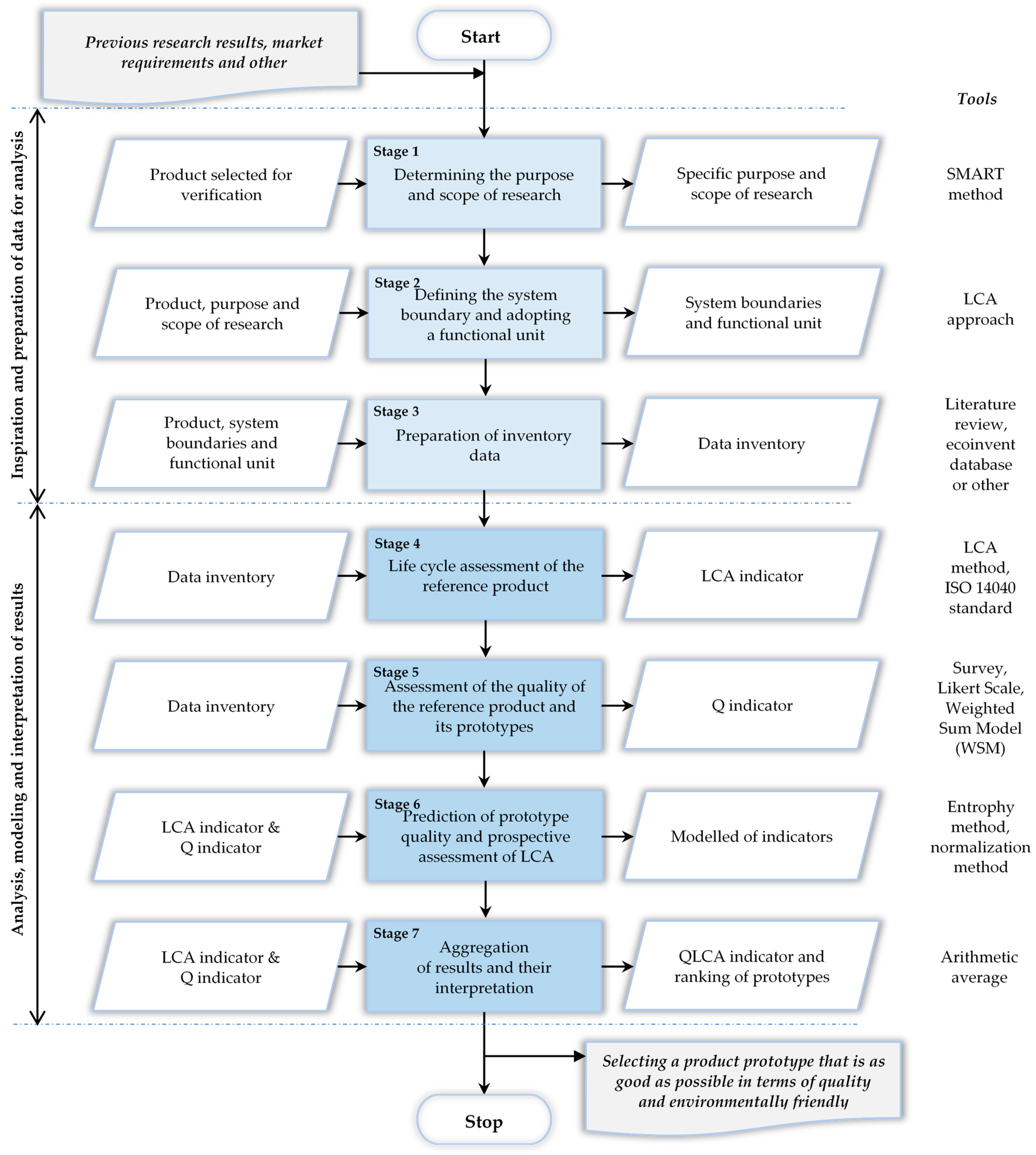
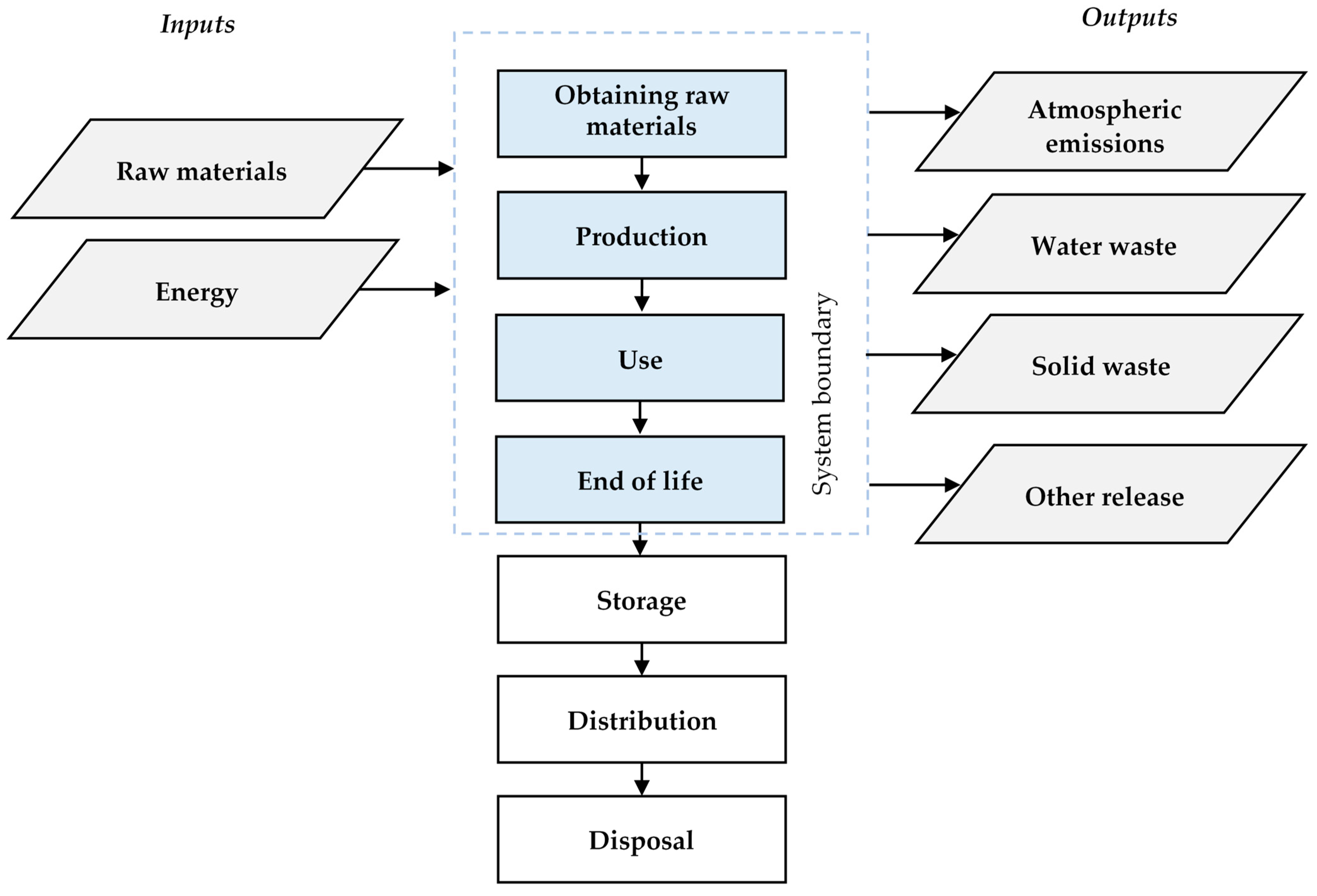
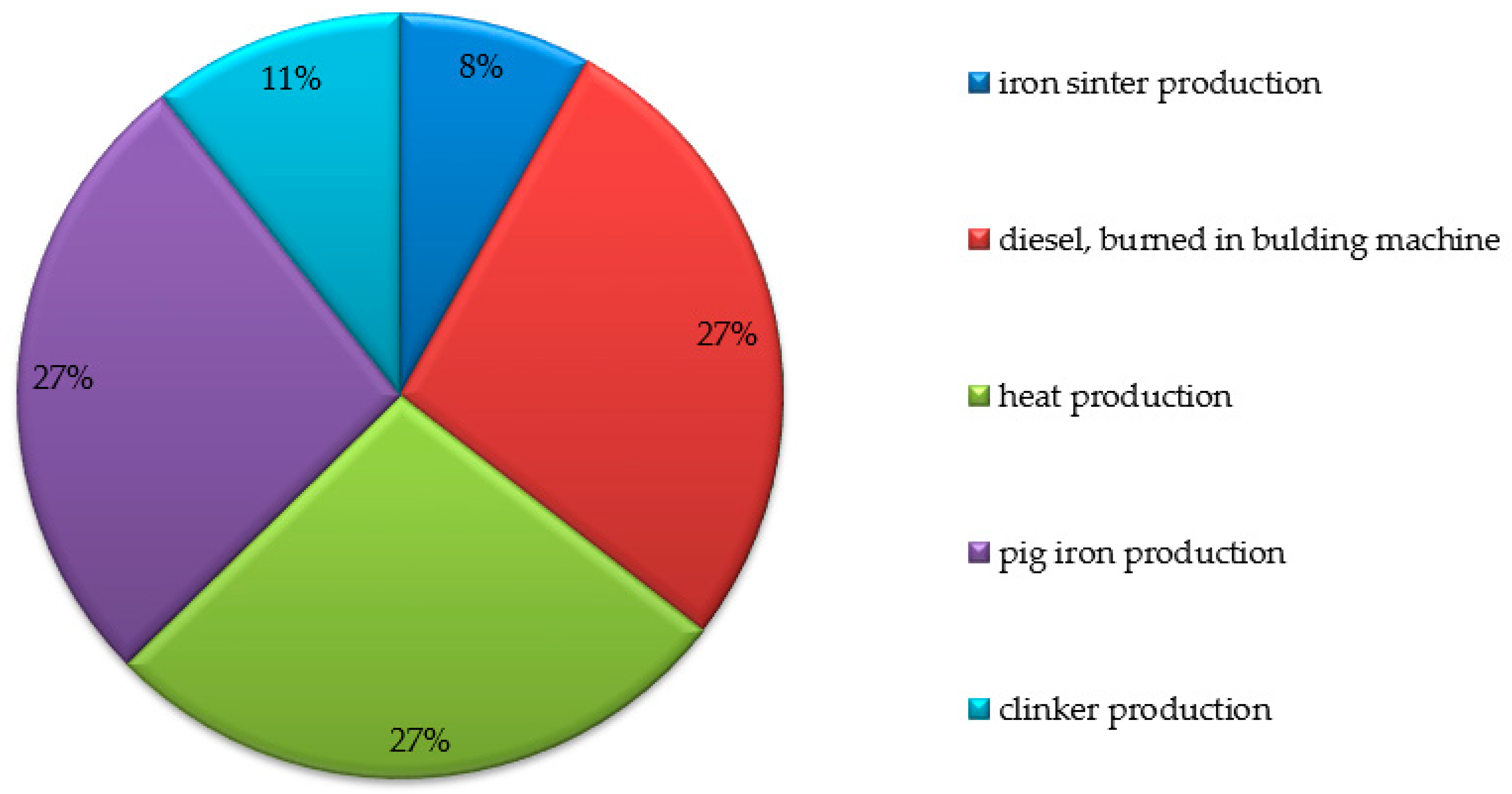
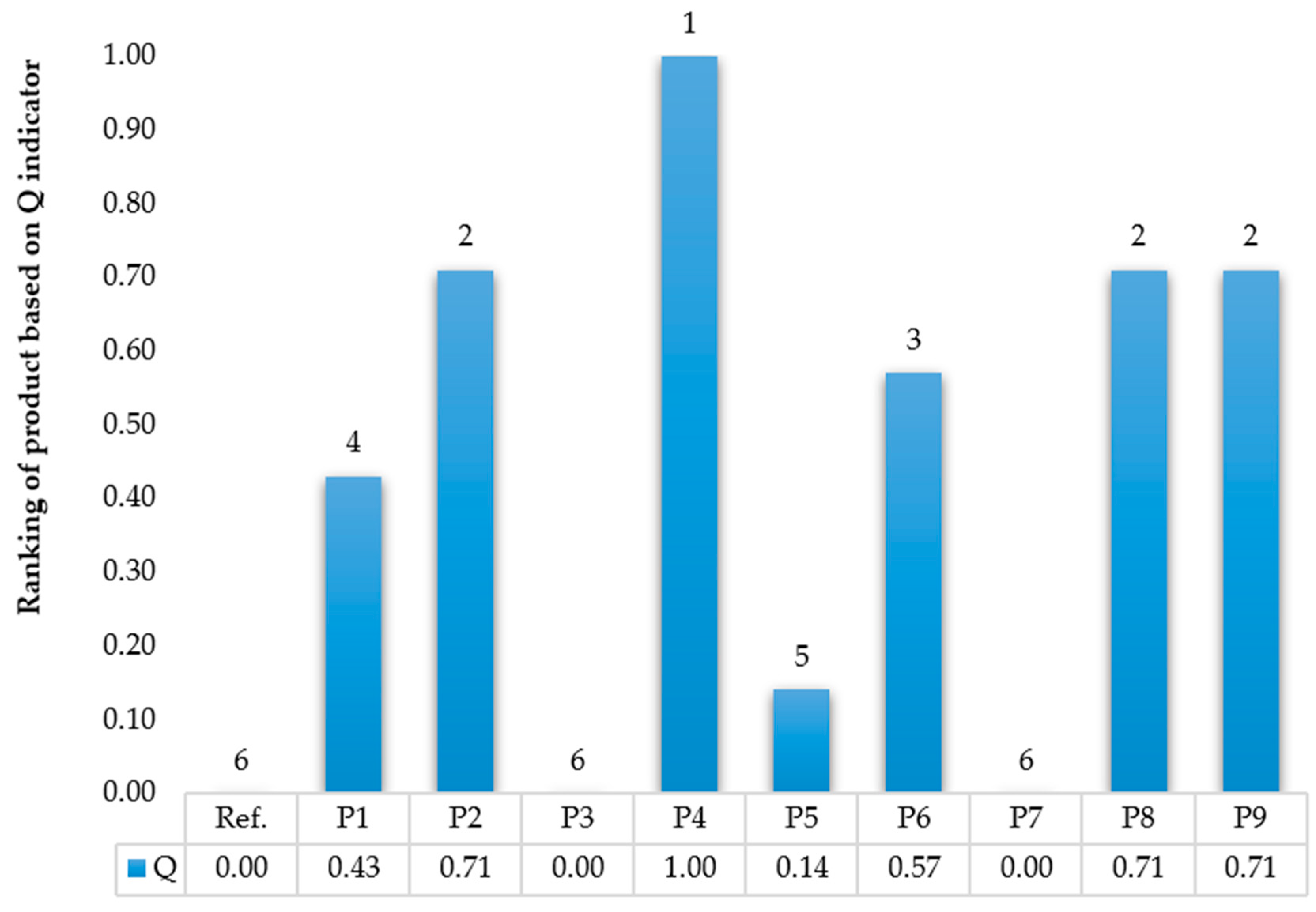
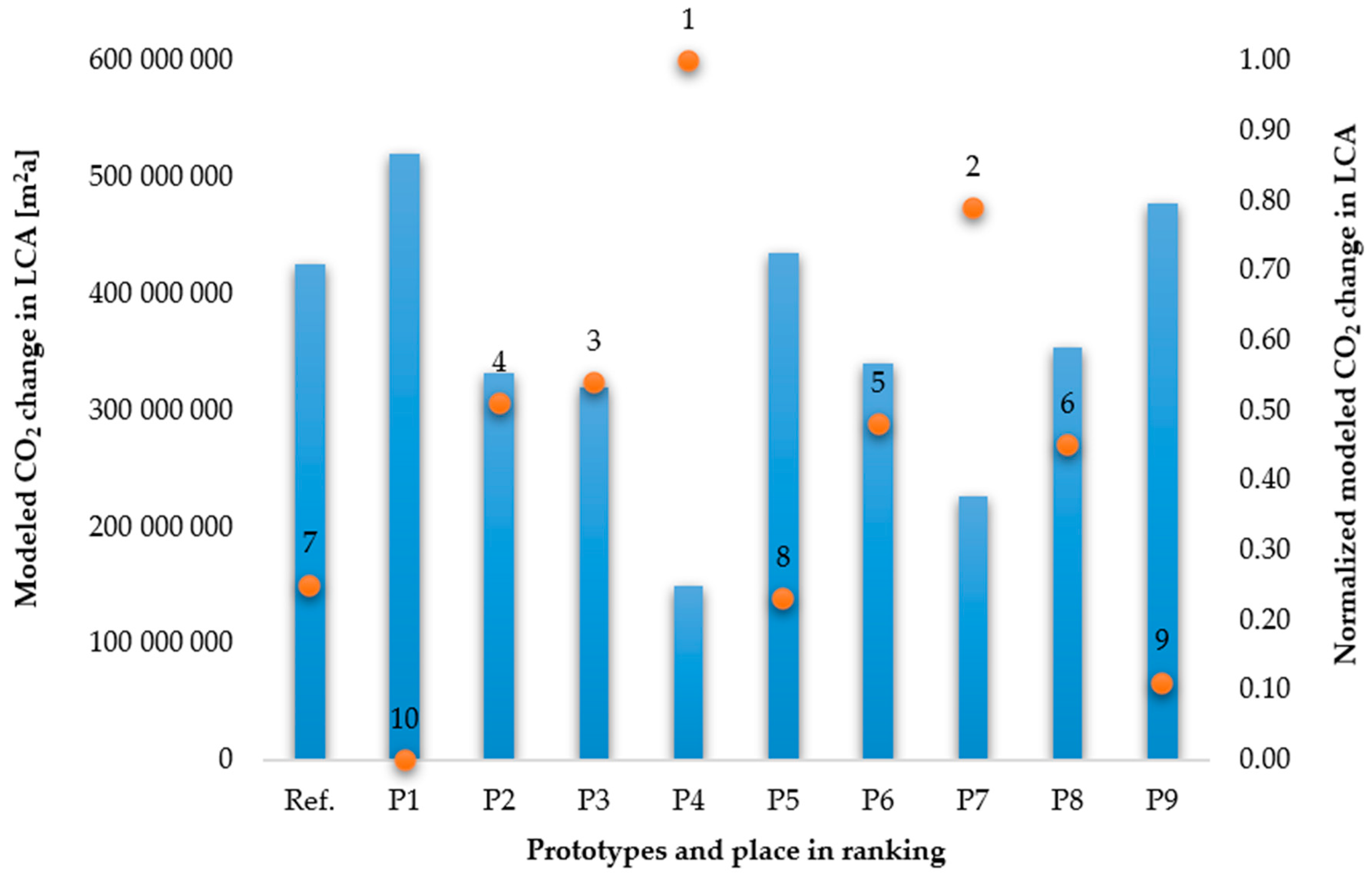
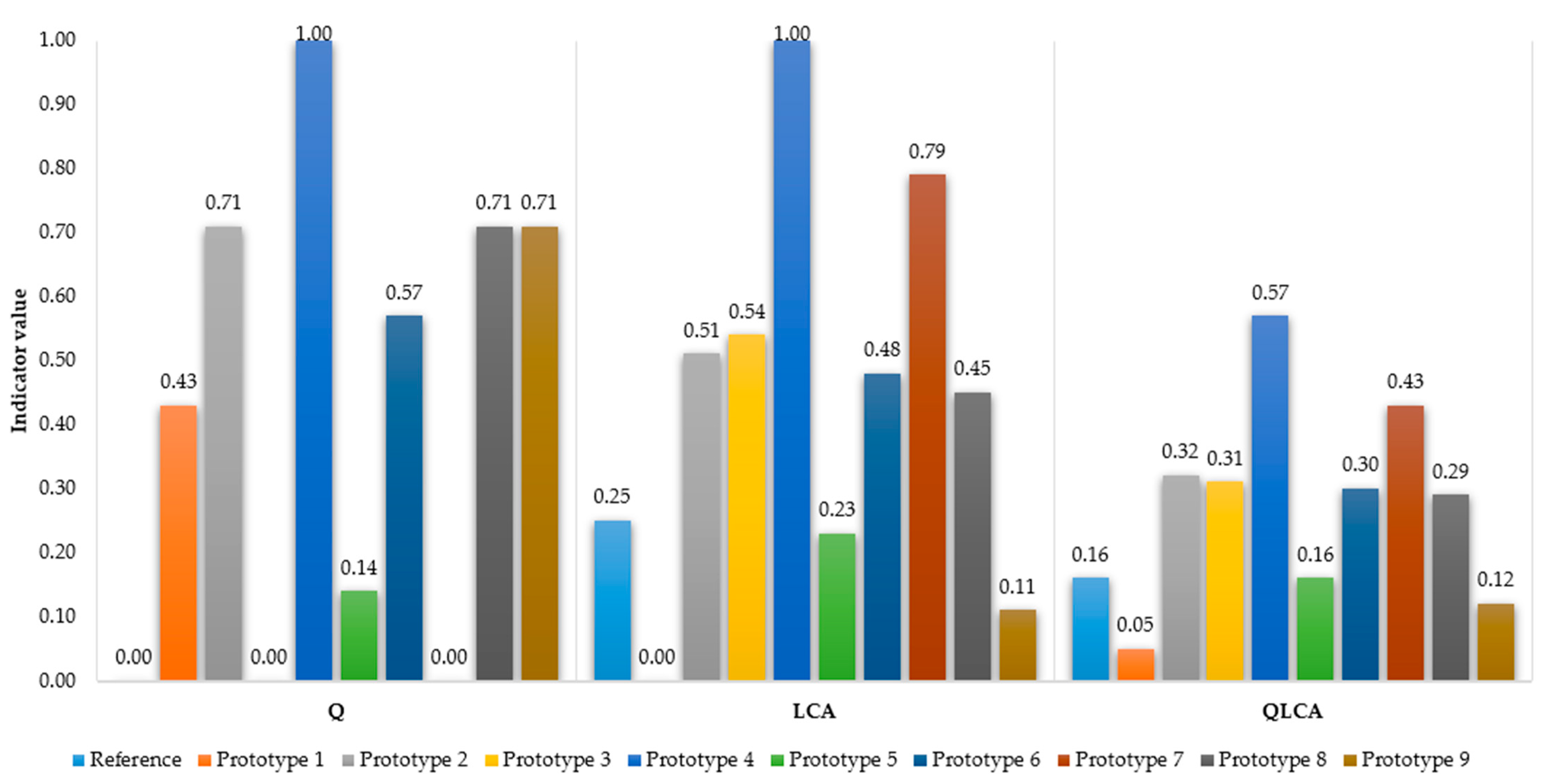
| Phases of LCA | Input/Output | Unit | Value |
|---|---|---|---|
| Obtaining raw materials and production | synthetic rubber | kg | 2.410 |
| natural rubber | kg | 1.820 | |
| black carbon | kg | 1.870 | |
| precipitated silica | kg | 0.960 | |
| sulphur compounds | kg | 0.120 | |
| zinc oxide | kg | 0.160 | |
| mineral and plant oils | kg | 0.590 | |
| stearic acid | kg | 0.100 | |
| rubber from recycling | kg | 0.050 | |
| steel wires | kg | 1.110 | |
| textiles | kg | 0.460 | |
| polymer-polyurethanes | kg | 0.240 | |
| ethyl acetate | kg | 0.030 | |
| substance facilitating rubber gluing-butadiene glues | kg | 0.030 | |
| antiadhesive substance-silicon | kg | 0.250 | |
| remaining solvents | kg | 0.020 | |
| water | l | 45.140 | |
| electric energy | MJ | 1036.120 | |
| others | kg | 0.120 | |
| Use | furnace oil for power generation | l | 6.400 |
| high-speed diesel for power consumption | l | 0.303 | |
| End-of-life | used tyre [kg] | kg | 50.000 |
| water [L] | l | 45.140 | |
| electric energy [MJ] | MJ | 1036.120 | |
| mineral and plant oils [kg] | kg | 0.590 |
| Season | Tyre Class | Size | Load Index | Speed Index (km/h) | Rolling | Grip | External Noise (dB) |
|---|---|---|---|---|---|---|---|
| year-round | premium | 205/55R16 | 100–800 | H to 210 | Class A | Class A | 64–67 |
| summer | mean | 155/65R14 | 101–825 | Q to 160 | Class B | Class B | 68–70 |
| winter | economic | 155/70R13 | 102–850 | R to 170 | Class C | Class C | 71–75 |
| 175/70R13 | 103–875 | S to 180 | Class D | Class D | |||
| 185/65R15 | 104–900 | T to 190 | Class E | Class E | |||
| 155/65R13 | 105–925 | V to 240 | |||||
| 175/70R13 | 106–950 | W to 270 | |||||
| 165/60R14 | 107–975 | Y to 300 |
Disclaimer/Publisher’s Note: The statements, opinions and data contained in all publications are solely those of the individual author(s) and contributor(s) and not of MDPI and/or the editor(s). MDPI and/or the editor(s) disclaim responsibility for any injury to people or property resulting from any ideas, methods, instructions or products referred to in the content. |
© 2024 by the authors. Licensee MDPI, Basel, Switzerland. This article is an open access article distributed under the terms and conditions of the Creative Commons Attribution (CC BY) license (https://creativecommons.org/licenses/by/4.0/).
Share and Cite
Siwiec, D.; Pacana, A. Materials and Products Development Based on a Novelty Approach to Quality and Life Cycle Assessment (QLCA). Materials 2024, 17, 3859. https://doi.org/10.3390/ma17153859
Siwiec D, Pacana A. Materials and Products Development Based on a Novelty Approach to Quality and Life Cycle Assessment (QLCA). Materials. 2024; 17(15):3859. https://doi.org/10.3390/ma17153859
Chicago/Turabian StyleSiwiec, Dominika, and Andrzej Pacana. 2024. "Materials and Products Development Based on a Novelty Approach to Quality and Life Cycle Assessment (QLCA)" Materials 17, no. 15: 3859. https://doi.org/10.3390/ma17153859







